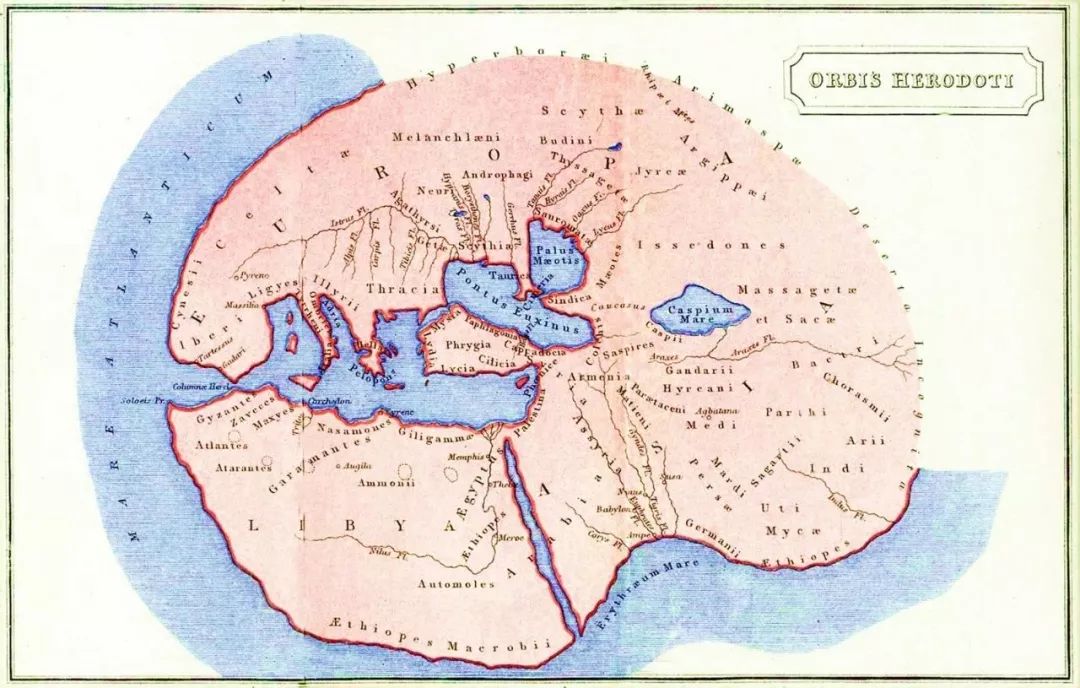Thanx!

quote:
Originally posted by rasol:
Anyone have information on these documents?Supposedly the Papyrus of Hunefer is currently at the London Museum, and comments on the origins of the Kemetians:
"we came from the beginning of the Nile were God Hapi dwells, at the foothills of the Mountains of the Moon" [Great Lakes Region - central Africa]
Accurate translation?
Something definitely worth looking further into.
quote:
rasol writes:
Anyone have information on these documents?
Supposedly the Papyrus of Hunefer is currently at the London Museum, and comments on the origins of the Kemetians:
"we came from the beginning of the Nile were God Hapi dwells, at the foothills of the Mountains of the Moon" [Great Lakes Region - central Africa]
Accurate translation?
Are you talking about the Papyrus of Hunefer which is the same as that of Ani, or in other words the "Book of the Dead"?
In any case, it is consistent with every thing we know from the Mdu Nter. It may surprise a few, but Egyptology has always maintained the southern African origins of the Ancient Egyptians. (Which explains why a handful of latter-day racist mavericks concocted the 'Hamitic' myth)
Here is EW Budge's account of the origins of the Ancient Egyptian language, and consequently the Ancient Egyptians themselves:
quote:
It is impossible for me to believe that Egyptian is a Semitic language fundamentally. There are a very large number of words that are not Semitic and were never invented by a Semitic people. These words were invented by one of the oldest African people of the Nile valley of whose written language we have any remains. Their home lay far to the south, and all that we know of Predynastic Egypt suggests that it was in the neighborhood of the **Great Lakes.
EW Budge, Hieroglyphic Dictionary, Dover, 1920
It isn't just in the text of Hunefer, but in the vocabulary of the language when referring to these southern African regions as:
"Land of the beginning"
"Land of our beginnings"
"Land of the ancestors"
"Land of the founders"
"The Holy land"
etc., etc. --from the beginning to the end of Ancient Egyptian civilization.
...
**geographical location of the "Mountains of the Moon"
[This message has been edited by Wally (edited 20 January 2005).]
quote:
Originally posted by Wally:
09 December 2004
It is human nature, quite simply, that whenever anyone does not want to examine critical evidence (in this case; the ethnicity of the Ancient Egyptians), it is out of fear that one's preconceived notions may have to be changed. They would much rather change the subject. You can do a case study of this phenomena on this site alone!
quote:
Originally posted by Wally:
It isn't just in the text of Hunefer, but in the vocabulary of the language when referring to these southern African regions as:
"Land of the beginning"
"Land of our beginnings"
"Land of the ancestors"
"Land of the founders"
"The Holy land"
etc., etc. --from the beginning to the end of Ancient Egyptian civilization.
...
**geographical location of the "Mountains of the Moon"
I'm just wondering what specific passage is actually being translated: "we came from the beginning of the Nile were God Hapi dwells," etc.. Is that 'from' the Book of the Dead?
quote:
Originally posted by rasol:
I'm just wondering what specific passage is actually being translated: "we came from the beginning of the Nile were God Hapi dwells," etc.. Is that 'from' the Book of the Dead?
quote:
Originally posted by rasol:
Anyone have information on these documents?Supposedly the Papyrus of Hunefer is currently at the London Museum, and comments on the origins of the Kemetians:
"we came from the beginning of the Nile were God Hapi dwells, at the foothills of the Mountains of the Moon" [Great Lakes Region - central Africa]
Accurate translation?
[This message has been edited by rasol (edited 20 January 2005).]
There is no such text as quoted. Nobody but one person has ever
claimed to have seen it and when called on it was unable to produce
it for others to view, hence being nonreplicable it has no scientific
value. When this anecdote first surfaced in 1986 the supposed
document was said to be in the library of
Syracuse University in
New York.
We must be exacting and critical of evidence demanding documentation
even from respected authorities not accepting anything just on their word.
quote:
Originally posted by alTakruri:
There is no such text as quoted. Nobody but one person has ever
claimed to have seen it and when called on it was unable to produce
it for others to view, hence being nonreplicable it has no scientific
value. When this anecdote first surfaced in 1986 the supposed
document was said to be in the library of
Syracuse University in
New York.We must be exacting and critical of evidence demanding documentation
even from respected authorities not accepting anything just on their word.
Thanx! 
The Edfu text is claimed to have been a real text about metal smiths coming from the south establishing a colony in Egypt. Some scholars have attested to this document being authenic;while others claim it was simply profaganda by Ptolemic era priests in Egypt over a land dispute around Aswan. I am not sure about the Papyrus of Hunefer,but I believe Dr. Ben quoted it.
alTakruri, what is your comment on Dr. Ben's quotation of the Papyrus of Hunefer in his book?
quote:
Originally posted by ausar:I am not sure about the Papyrus of Hunefer,but I believe Dr. Ben quoted it.
alTakruri, what is your comment on Dr. Ben's quotation of the Papyrus of Hunifer in his book?
I gave my opinion already.
Doc Ben has dozens of books which one and which page do you mean?
I think I remember this Mountains of the Moon "quote" from Black
Man of the Nile and his Family. Then again he uses it in a speech
before the Minority Ethnic Unit of the Greater London Council.
Has anyone but anyone ever properly cited the
quoted text under
question? The Papyrus of Hu-nefer (British Museum number 9901)
is written in hieroglyphic not hieratic. When researchers scour the
supposed source they can’t seem to find the questioned quote
which makes a collective historical statement concerning all Kmtyw
even though the scroll itself is an individualistic and very personal
afterlife religious text.
I used to rely on Doc Ben’s statement but now being older and
being able to apply critical analysis I cannot accept work that is
irreplicable no matter how honored its author may be.
If someone can supply the sheet and line number of a Papyrus
of Hunifer with the Mountains of the Moon quote I will gladly
revise my views. Until then I remain skeptical. My interest is in
history not ideaology.
I think that the metal smiths which Ausar is referring to are the 'Mesnitu'(the blacksmiths) who were identified as the Shemsu Hor or "Horus's followers" - information on them are secondary, I have personally never seen the documents themselves.
The only conclusive document that is readily available is the Papyrus of Ani, which, despite the philosophical aspect, is predominantly a text on the Anu rule of Ancient Egypt.-- ie, Osiris, the Anu scribe...
Unlike my brother alTakruri, My primary interest is in ideology, the ideas which propels history.
[This message has been edited by Wally (edited 21 January 2005).]
quote:The "Mountains of the Moon" phrase was originally by Diogenes and Budge's "Great Lakes" phrase were combined into one fabricated quote by this self-proclaimed Ethiopian Falasha/Puerto Rican who advocated for 'White' Genocide:
Originally posted by alTakruri:
quote:I gave my opinion already.
Originally posted by ausar:
I am not sure about the Papyrus of Hunefer,but I believe Dr. Ben quoted it.
alTakruri, what is your comment on Dr. Ben's quotation of the Papyrus of Hunifer in his book?
Doc Ben has dozens of books which one and which page do you mean?
I think I remember this Mountains of the Moon "quote" from Black
Man of the Nile and his Family. Then again he uses it in a speech
before the Minority Ethnic Unit of the Greater London Council.
Has anyone but anyone ever properly cited the
quoted text under
question? The Papyrus of Hu-nefer (British Museum number 9901)
is written in hieroglyphic not hieratic. When researchers scour the
supposed source they can’t seem to find the questioned quote
which makes a collective historical statement concerning all Kmtyw
even though the scroll itself is an individualistic and very personal
afterlife religious text.
I used to rely on Doc Ben’s statement but now being older and
being able to apply critical analysis I cannot accept work that is
irreplicable no matter how honored its author may be.
If someone can supply the sheet and line number of a Papyrus
of Hunifer with the Mountains of the Moon quote I will gladly
revise my views. Until then I remain skeptical. My interest is in
history not ideaology.


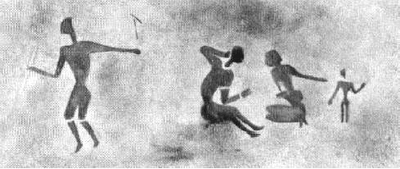
quote:Read above by Al-Takruri, it has been established that the Mountains of the Moon quote was probably made up or fabricated by Ben Yocchnan. Nothing more nothing less.
Originally posted by rahotep101:
The Hunefer papyrus is a regular 'Book of the Dead', its text should be the same as most other books of the dead, and as far as I know ir does not contain anything about southern origins or 'mountains of the moon'. I have seen the original papyrus at the British Museum, where it was recently part of the Book of the Dead exhibition.
quote:Caucasiod is a debunked descriptor based on Eye-ball anthropology and 19th century racists. It is alos the Crutch of Euroclowns who need to claim African Civilizations that was created and founded by Africans Further South.
Originally posted by rahotep101:
The illustrations show the deceased Hunefer as reddy-brown skinned caucasoid, and his wife and female relations as light skinned.
quote:Let me guess, it is Not Symbolic when you have so called Light skin but its symbolic when you have this huh..
Originally posted by rahotep101:
The gods, interestingly, are also mostly shown lighter skinned than Hunefer himself (apart from Osiris who is dark green), which counts against the notion that Egyptians ascribed Ethiopian origins to their gods.


![[Eek!]](eek.gif)
quote:Thanks to Sundjata for bringing this article to my attention:
Originally posted by Rahotep101:
...but there is no obvious symbolic reason for the generally lighter depiction of most Egyptian females
quote:---Kamugisha (2003)
A survey of a number of scholars, most writing in response to Black Athena, reveals a similarly problematic approach to the African nature of Egypt. John Baines, professor of Egyptology at Oxford, in his attack on Black Athena II in the New York Times, is similarly a victim of the confused approach seen in Kelley. For Baines, ancient Egypt 'was an African society of diverse ethnic origins'. (38) He further seems to believe that Egyptians' representations of themselves in paintings as reddish-brown (men), yellow (women) and of the people to the south as black is of importance in determining their actual physical characteristics--surely one of the more astounding statements made recently on the ethnicity of the ancient Egyptians.
quote:The whole "outdoor" argument has been discussed time and time again here. Most recently here. As seen by the citation of Kamugisha, the ancient Egyptians representations of themselves as yellow and red cannot be take to literal. You taking one image doesn't change that those colors didn't necessarily depict actual skin tones, unless you can offer evidence to the contrary?
Women being inexplicably lighter skinned than their husbands is something still to be seen among modern Egyptians, so go figure. (By contrast, it's not something to be seen in Somalia, as a rule.) I'm no dermatologist but I suspect this has something to do with the sun, and the men spending more time out under it.
quote:So, after your "yellow" argument has been done away with, you claim they were pink? They don't look "pink" LOL. Did you read the thread I hyperlinked? I think it would serve you better to post there, instead of this old thread.
Originally posted by rahotep101:
The women in the Hunefer papyrus are not 'yellow' but rather pink. One of the deities, moreover, appears to have auburn hair- although that could be a head cloth, to be fair (in the top corner of the montage image posted previously). The Egyptians on the photo I just posted (including their slightly blond child) are evidently of the same ethnicity as the people represented in the ancient papyri. Their colour and phenotype match. (This is a family who make their living on the Nile in Cairo, incidentally).




quote:I find it funny how you Eurocentrics love to talk about "Lighter" Females in A. Egyptian are as if this is even the Norm. If you examine majority of the Very Few Selected Papyrus art shown to the world alot of times the Females are not painted and thus left the color of the Papyru, However if you examine Tomb art it is another story...Also Funny is how the Tomb art rather than Papyrus Art is more reflective of Reality.
Originally posted by rahotep101:
but there is no obvious symbolic reason for the generally lighter depiction of most Egyptian females.

quote:Once again what Gods are we talking about?? Osiris was depicted Darker, Anubis, Amun a God Linked to Gebel Barkel, Khanum the God of Elaphantine.
Originally posted by rahotep101:
And if the Egyptians considered the gods to be Ethiopians, as some claim, then they would surely have erred on the dark side rather than making even the male gods lighter in colour than the Egyptian mortal man.
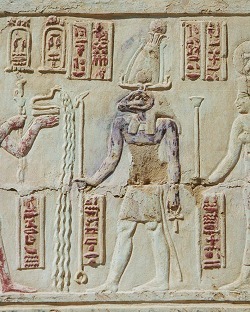






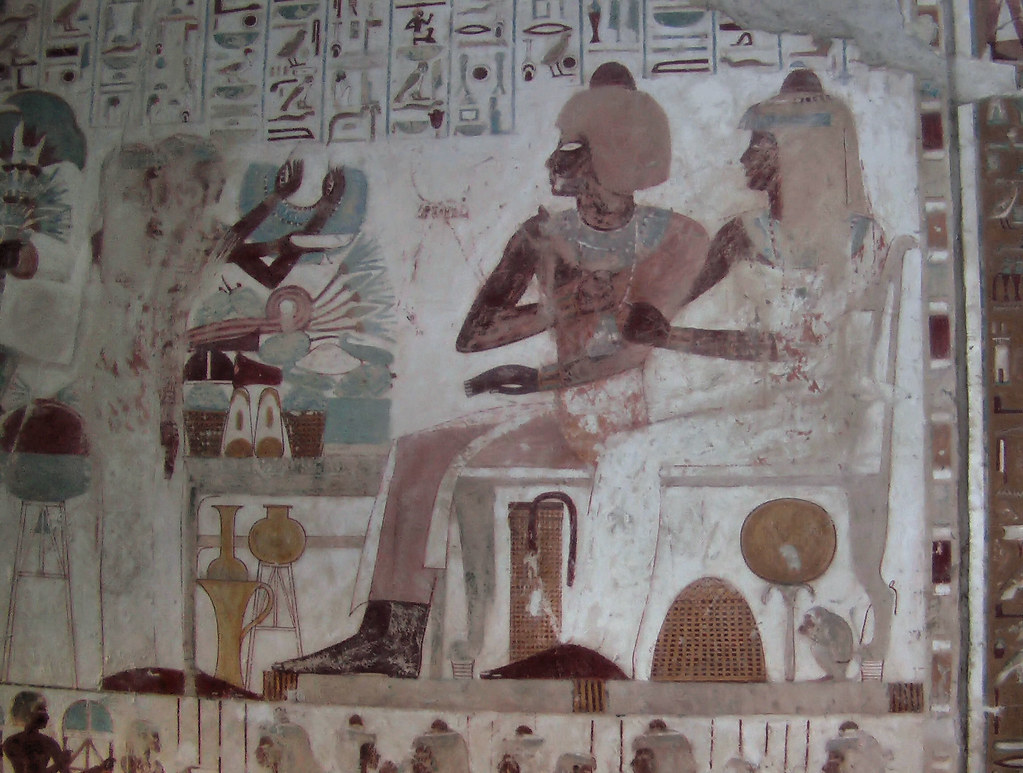
quote:
Originally posted by rahotep101:
Egyptian females, however, were often light natural flesh tone.
quote:I was asking for evidence that modern Egyptians are reflective of ancient Egyptians, a claim you fail to substantiate. Go here:
Evidence? I put it to you that this colour here is pink
quote:And the characteristic light skin of Egyptian women is not supposed to be reflective of their actual skin tone. Nefertari image I'll say may be more reflective of her actual skin tone, which to me looks like a brownish color.
Egyptian females, however, were often light natural flesh tone
quote:Nefertari..
Originally posted by rahotep101:
Uploaded with ImageShack.us
Uploaded with ImageShack.us
The queen is even given blishing cheeks and red lips, there is nothing 'yellow' about her, it seems to me.
Uploaded with ImageShack.us
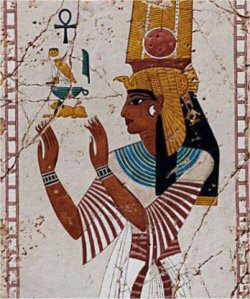





quote:You've got to be joking, are you joking? I knew you were naive, but come on.
Interestingly with the second image where the queen is playing senet, she is still not black, i.e. she is not dark brown, she is dark pink.









quote:
Originally posted by rahotep101:
The other image is still decidedly on the pink side, as opposed to brown. Far be it from me to use photoshop for anything beyond value checking.
Uploaded with ImageShack.us
I must say it's a bit of a rich to nit picking about that when I've seen Afrocentrists showing this version...
Uploaded with ImageShack.us
quote:Did you see us post that image? No, you didn't. That is what we call a Strawman argument
I must say it's a bit of a rich to nit picking about that when I've seen Afrocentrists showing this version...
![[Big Grin]](biggrin.gif)
quote:I have already addressed the Papyrus of Hunefer already as most of the Papyrus Art was left unpainted or the paint is faded. Look at the Image I used above.
Originally posted by rahotep101:
@JustCallMeJari I was talking specifically about the Papyrus of Hunefer when I said most of the the gods were represented as light skinned, lighter than Hunefer himself, and this is fairly undeniable.
quote:Even the Image you are using has Faded considerably. You are in Denial if you believe those Images depict reality and are Not Faded..
Originally posted by rahotep101:
By the way the images of the pale skinned Nefertari standing next to darker skinned gods in her tomb also gives the lie to the accusation that the images I showed were faded.
quote:It does'nt matter if you dignify it or not.
Originally posted by rahotep101:
I won't dignify the claim that they are photoshopped with an answer, suffice to say that if they were I'm sure this would be easily exposed (as easily as I have exposed Afrocentrist fakery), so what would be the point?

quote:How Merciful of you..LOL.
Originally posted by rahotep101:
Obviously there were many dark skinned Egyptian, male and female, especially in the south, but not I think darker than the present population, who are a mixed bunch. As I've said before and will again, if you're searching for the faces of ancient Egyptians, look at the living Copts. I don't believe in gods of any colour anyway, but if there are gods I'm sure they're as indifferent as they are invisible. Colour is not a property of deities.
quote:Fancy that! Especially as the results coming up are mostly for 'dark skinned people' and the word pink must be somewhere else on the given websites.
Originally posted by L':
quote:Did you see us post that image? No, you didn't. That is what we call a Strawman argument
I must say it's a bit of a rich to nit picking about that when I've seen Afrocentrists showing this version...
Seriously, dark-skinned anything in Africa equates to what we know as "black people". Ironically, I Googled the term Dark pink skinned people and the dark ones are black
http://www.google.com/images?hl=en&source=hp&biw=1280&bih=557&q=Dark+pink+skinned+people&gbv=2&aq=f&aqi=&aql=&oq=
LMAO![[Big Grin]](biggrin.gif)
quote:I have seen the original papyrus, remember, and I can assure you it is fully painted, and is in excellent condition. If all the figurs were originally a dark colour, they would all be a pale colour now, and this is the case neiter with the papyrus (or others like it) or with Nefertari's tomb. Why is Nefertari's hand not the same colour as Horus'? Do try to be logical.
Originally posted by Just call me Jari:
[I have already addressed the Papyrus of Hunefer already as most of the Papyrus Art was left unpainted or the paint is faded. Look at the Image I used above.
quote:Definition of black = dark skinned. I really have no idea what the hell a dark skinned pink person is, that is pretty much something you link to hear, there really isn't such an actual color. I just posted that because that is what came up- dark skinned people.
Fancy that! Especially as the results coming up are mostly for 'dark skinned people' and the word pink must be somewhere else on the given websites.
quote:Dark skinned people of African descent i.e., biologically African. Not recent immigrants.
Dark skinned people in Africa are not necessarily 'black'. Are the descendants of the Indians who moved to South Africa under the British Empire blacks? Is Gandhi's granddaugher, Ela Ghandi, a black African? Going back much further, it is a complete myth that there is one African race, any more than there is one Asian one.
quote:
Originally posted by rahotep101:
quote:I have seen the original papyrus, remember, and I can assure you it is fully painted, and is in excellent condition. If all the figurs were originally a dark colour, they would all be a pale colour now, and this is the case neiter with the papyrus (or others like it) or with Nefertari's tomb. Why is Nefertari's hand not the same colour as Horus'? Do try to be logical.
Originally posted by Just call me Jari:
[I have already addressed the Papyrus of Hunefer already as most of the Papyrus Art was left unpainted or the paint is faded. Look at the Image I used above.
Obviously you can find images of women darker than Nefertari as she is painted in her tomb, and you can find men painted lighter shades. The simple reason for this is that there were such people in ancient Egypt.
quote:What do fringe Afro-centrics have to do with us?
I wouldn't like that, but I have come across Afrocentrists claiming the Ancient Britons/Celts/Vikings/Anglo Saxons were black, just as I've seen actual Egyptians getting undeserved abuse and being called impostors and squatters in a black land.
quote:Rahotep101- I have already addressed your claims about more genetic input from south of Egypt than north. I am really starting to believe that you don't read a thing anybody tells you. Most of the African lineages in Egypt are pre-pharanoic lineages, V, XI, and IV etc., introduced in late Pleistocene to mid-Holocene.
Afrocentrists seem to be forever exaggerating the impact of migration to Egypt from Eurasia, and ignoring the fact that there was a more than equivalent amount of movement from black Africa over the same period
quote:That makes no sense. All of your moronic claims here have been shut down in the other thread.
Hence the need to remind people that migration potentially enhanced rather than diluted the African component of Egypt's makeup.
quote:I agree.
This is a wholly unfounded conspiracy theory.
quote:Africa cannot be a homogeneous race as race doesn't exist. Africa is very diverse, and admixture doesn't explain that. Distance from sub-Saharan Africa is what determines phenotypic and genetic diversity.
Afrocentrics sometimes also do presume to take credit for all Europe's achievements, by promoting the myth that ancient Egypt was 'black African' (as if Africa was homogenous race) and that the Greeks derived all their arts and sciences from Egypt, and that all Europe's advances are founded on Egypt via Greece.
quote:How Egyptians chose to represent themselves is irrelevant in light of the biological data we have had for years now. Egyptians and Nubians were biologically the closest, with a south north cline. In modern Egypt there is a north-south cline, and, due to the substantial Middle Eastern genes in the modern population, their is continuity into the Near East that wasn't present in the past. You forget that Egypt was populated by sub-Saharan Africans...
I think Dr Hawass went too far saying that Egyptian civilization had 'no black element', bit his definition of black is clearly different from that of others. Most Egyptians apparently do not and did not identify themselves as black Africans, however oursiders saw them. They clearly differentiated themselves from the Nubians.
quote:Just because their culture wasn't exactly the same, doesn't justify classifying them as separate "races". Especially since they were ethnically and biologically the closest to the ancient Egyptians. You cannot name another population closer to the ancient Egyptians than the Sudanese
The 25th dynasty was set apart as it remained a dynasty of foreign occupiers. They retained their Nubian base and were buried in Nubia. As rulers of their former masters, the Nubians were perhaps kinder to Egypt than Egypt had the right to expect, but they did not naturalize, and there was no merging of the kingdoms. Egyptian Nubians are still very much an ethnic and cultural group unto themseves.
quote:There was not a major Near Eastern influence, biologically or culturally in ancient Egypt. Such influences occurred later on.
I think you underplay the boost that contact with the other cultures of the fertile Crescent gave to Egypt when it was a fledgling civilization. This contact with other advanced civilizations helped to propel Egypt to greatness while Nubia played catch-up. While Egypt has an African context, it also has a Mediterranean and Middle-Eastern one. It was connected to trade in the Eastern Med and across Aisa as far as India and Afghanistan. Many of the various capitals were in the north, Sakkara, Memphis, Tanis, Sais, Avaris, Pi Ramses, Alexandria etc, and there is no particular reason to think they were not built by lower Egyptians. They were a stone's throw from Sinai and the Holy Land, but a long way from the heart of Africa.
quote:---Timothy Kendall
It is Piye's Year 3 Stele that preserves the earliest Napatan record of the kingship tradition of Gebel Barkal. Here he declares that "Amun of Napata granted me to be ruler of every foreign country," and "Amun in Thebes granted me to be ruler of the Black Land (Kmt)" (FHN I 57; Reisner 1931, 89). The twin Amuns of Barkal and Karnak are presented here as mutually supportive aspects of each other, each giving the king a vital portion of his kingship. Only one Amun, however, is shown in the lunette. This is the ram-headed god of Napata, whom the text says gave the king "every foreign country." Yet we see that he is the one handing the king two royal crowns and thus also giving him the kingship of "the Black Land." One crown is the Red Crown of Lower Egypt, and the other is the cap crown, which obviously had some meaning analogous to, but not quite identical with, the White Crown. Here Amun of Napata seems to be granting the gift ascribed to Amun of Thebes. We wonder if there is an inconsistency here, or if we are to understand that the two gods are really exactly the same and perform the same tasks. We also wonder what the king really means here by the terms "foreign countries" and "the Black Land." Does the Red Crown of Lower Egypt symbolize "foreign countries"? Does the cap crown symbolize "Kemet"? "Kemet", in this case, would have to be understood here as a united Nubia and Upper Egypt. By the time of Harsiotef, "Kemet" had come to mean Kush (FHN II 446).
quote:It is strange, lol. I do not honestly see how he can think the Egyptian population stayed the same for 5,000 years, that makes no sense. He also seems to have an "Afro-centric" stereotype, so to speak, where he thinks everybody here agrees on the same things.
^I wonder why is it that when Eurocentrics can't refute certain facts, they start crying Afrocentrism and instead begin rehearsing arguments they've heard before offered against extremists who we clearly do not support. Hiding behind 'Black' as some racial apartheid term won't help either. Ancient Egyptians were Africans and the evidence presented is quite clear on that front. All of those typologically contrived racial terms are irrelevant to the established relationships shared between ancient Egyptians and other Africans in the wide body of literature. Empty, hallow pronouncements of denial and straw man rebuttals cannot change that simple and basic fact.
quote:Firstly, you are an imbecile. Copts DO indeed have Near Eastern ancestry at significant frequencies. I presented this to you numerous times in the other thread with the most recent articles. Why you chose to ignore the data presented in Hassan et al., (2008) is beyond me.
If you think that the ancient Egyptians invented the physical difference between themselves and their southern neighbours which is consistently reflected in their artwork esp in their break down of the different human races, then you will need to explain why they could have been so irrational.
The Y Chromosome study of Egyptian men (Lucote 2002) found only 10% Arab ancestry (except in Copts who have no Arab ancestry) & nearly negligible input from Romans, Greeks and Persians in the present population.

quote:Surely you must be retarded, now! I provided you with the genetic evidence in another thread:
Keita says that inhabitants of the Nile Valey are in the main, but not wholly, descended from the pre-neolithic regional inhabitants. This is very different from saying that Egyptians come from sub saharan Africa
quote:-- F. X. Ricaut and M. Waelkens (2008)
This finding is in agreement with morphological data that suggest that populations
with sub-Saharan morphological elements were present in northeastern Africa, from the Paleolithic to at least the early Holocene, and diffused northward to the Levant and Anatolia beginning in the Mesolithic. Indeed, the rare and incomplete Paleolithic to early Neolithic skeletal specimens found in Egypt—such as
the 33,000-year-old Nazlet Khater specimen (Pinhasi and Semal 2000), the Wadi Kubbaniya skeleton from the late Paleolithic site in the upper Nile valley (Wendorf et al. 1986), the Qarunian (Faiyum) early Neolithic crania (Henneberg et al. 1989; Midant-Reynes 2000), and the Nabta specimen from the Neolithic Nabta Playa
site in the western desert of Egypt (Henneberg et al. 1980)—show, with regard to the great African biological diversity, similarities with some of the sub-Saharan middle Paleolithic and modern sub-Saharan specimens. This affinity pattern between ancient Egyptians and sub-Saharans has also been noticed by several other investigators (Angel 1972; Berry and Berry 1967, 1972; Keita 1995) and has been recently reinforced by the study of Brace et al. (2005), which clearly shows that the cranial morphology of prehistoric and recent northeast African populations is
linked to sub-Saharan populations (Niger-Congo populations). These results support the hypothesis that some of the Paleolithic–early Holocene populations from northeast Africa were probably descendents of sub-Saharan ancestral populations.
quote:Define west and east.
There was also input from the west and the east. He also acknowledges a similar range of skintones and phenotypes among modern egyptians as there was in the past.
quote:LOL! You are just too stupid. I really won't bother with this as it has been demonstrated to you in the other thread how stupid this is.
Modern Egyptians can be told apart from Sudanese, for the most part, and the same was clealy true historically.
quote:Dude, you are referring to his old study which was corrected in 2005.
Brace found Egyptians to be close to Nubians, with ties to neolithic north Africa and modern Europe but not at all to sub saharan africans.
quote:-- F. X. Ricaut and M. Waelkens (2008)
This finding is in agreement with morphological data that suggest that populations
with sub-Saharan morphological elements were present in northeastern Africa, from the Paleolithic to at least the early Holocene, and diffused northward to the Levant and Anatolia beginning in the Mesolithic. Indeed, the rare and incomplete Paleolithic to early Neolithic skeletal specimens found in Egypt—such as
the 33,000-year-old Nazlet Khater specimen (Pinhasi and Semal 2000), the Wadi Kubbaniya skeleton from the late Paleolithic site in the upper Nile valley (Wendorf et al. 1986), the Qarunian (Faiyum) early Neolithic crania (Henneberg et al. 1989; Midant-Reynes 2000), and the Nabta specimen from the Neolithic Nabta Playa
site in the western desert of Egypt (Henneberg et al. 1980)—show, with regard to the great African biological diversity, similarities with some of the sub-Saharan middle Paleolithic and modern sub-Saharan specimens. This affinity pattern between ancient Egyptians and sub-Saharans has also been noticed by several other investigators (Angel 1972; Berry and Berry 1967, 1972; Keita 1995) and has been recently reinforced by the study of Brace et al. (2005), which clearly shows that the cranial morphology of prehistoric and recent northeast African populations is
linked to sub-Saharan populations (Niger-Congo populations). These results support the hypothesis that some of the Paleolithic–early Holocene populations from northeast Africa were probably descendents of sub-Saharan ancestral populations.
quote:See, I'll tell you why north Africa could not have been a source for gene flow:
(Even Nubians group distantly from sub-saharans). So aside from Southern Nilotic influences there were at least two sources of caucasoid influence on predynastic Egypt, i.e. Berber N. Africa and the
Middle East. This is why many ancient Egyptian images look like Mediterranean caucasians more than black Africans. This is why Moses could be mistaken for an Egyptian, according to the Bible. (and so could Joseph).
quote:-- Karima Fadhlaoui-Zid et al., (2011)
The distribution of subsets of haplogroups U6 and M1 also suggests the presence of a discontinuity between Libya and Egypt, separating western North Africa from eastern North Africa. Even if both haplogroups are thought to have been carried by a back-to-Africa migration from the Near East, significant increased U6 frequencies have been detected in the West compared to the East. The network of all U6 sequences found in the database presents two nodes with star-like shape, U6a* and U6a1. In a similar way, M1a1 is the node with starlike topology in haplogroup M1, and the node where most of the eastern sequences are found. Time estimates of these nodes are 13.5 6 3.7, 13.0 6 5.7, and 13.1 6 7.0 kya for haplogroups U6a*, U6a1, and M1a1 respectively. The most plausible explanation of the frequency distribution of M1a, U6, and M1b1 lineages, their coalescence age estimates, and the star-like shape would be an early split in the back to Africa migration followed by a period of stability and a period of expansion. The split would have produced two different migration waves, one westward, represented by U6 and possibly M1b1 in lower frequencies, and the other southward, represented by M1a. Each haplogroup would have increased its frequency by drift and subsequently accumulated diversity over time. Coalescent time estimates point to a possible second expansion of these haplogroups at the end of the LGM, simultaneously with some Eurasian haplogroups, as suggested by Olivieri et al. (2006). Moreover, all but one M1a1 sequence are found in eastern North Africa, which suggests that this subclade might have appeared in the East, and only after that have migrated westwards at this period.
quote:The above doesn't even deserve a response
This is why many ancient Egyptian images look like Mediterranean caucasians more than black Africans. This is why Moses could be mistaken for an Egyptian, according to the Bible. (and so could Joseph).
quote:Again, not applicable to northeast Africans.
Mummy DNA studies from the Dakhleh Oasis region reveal much less maternal African DNA than that found in modern Egyptians. This is evidence of black migration, or of Egyptians having children by black female slaves. (Well it was good enough for the Medici).
quote:Originally posted by Ausar:
The arab slave trade is well documented and was long lasting. I don't know how you can be so obtuse as to deny its likely consequences for Egypt's ethnic makeup. There were both white and black slaves in Egypt. Apparently circassian females were more desirable for harems but black africans were also used in this way, (and were more cheaply available).
quote:ausar is a Coptic Egyptian btw
Mau, I could argue that the pale skinned Egyptians are mixed with the millions of white slaves brought into Egypt. White slaves were most desired by the elite. Most of the dark skinned Egyptians live in southern Egypt were the slave trade was non-existent. Plus most of the black African slaves brought into Cairo and Alexandria tended to be either slave soldiers or eunuchs. Neither left many offspring. The written records also account that important Sudanese women were not fertile and did not produce enough offspring to reproduce.
quote:Of course it is.
Originally posted by L':
[qb]quote:It is strange, lol. I do not honestly see how he can think the Egyptian population stayed the same for 5,000 years, that makes no sense. He also seems to have an "Afro-centric" stereotype, so to speak, where he thinks everybody here agrees on the same things.
^I wonder why is it that when Eurocentrics can't refute certain facts, they start crying Afrocentrism and instead begin rehearsing arguments they've heard before offered against extremists who we clearly do not support. Hiding behind 'Black' as some racial apartheid term won't help either. Ancient Egyptians were Africans and the evidence presented is quite clear on that front. All of those typologically contrived racial terms are irrelevant to the established relationships shared between ancient Egyptians and other Africans in the wide body of literature. Empty, hallow pronouncements of denial and straw man rebuttals cannot change that simple and basic fact.
BTW, do you think that light skin in north Africa can be due to SLC24A5 111*A? I had heard you say it elsewhere. What was the study that said that again?
quote:Herodotus was not Egypitan and he lived 100's of years after the fact. This is what I mean by your preference for poor quality sources. The priests of Ammon embraced the Kushites as revivers and as shown to you, what is interesting is that part of Egypt [the north] at this time that was occupied by actual foreigners (Assyrians) was considered "foreign land".
Originally posted by Rahotep:
The 25th dynasty was obviously foreign. Herodotus lists the 'Ethiopian' kings of Egypt separately from the native ones
quote:That's not what I heard
L' Copts may have near eastern ancesty, but it is not the result of the Arab Muslim invasion, so must be older. It's not the result of Greeks or Romans, either, and there was no mass Persian settlement, so that's taking you right back into Ancient Egyptian times. This is surely old near-eastern admixture, not recent.
quote:--Semino et al. 2004
According to this interpretation, the first migration, probably in Neolithic times, brought J-M267 to Ethiopia and Europe, whereas a second, more-recent migration diffused the clade harboring the microsatellite motif YCAIIa22-YCAIIb22 in the southern part of the Middle East and in North Africa. In this regard, it is worth noting that the median expansion time of the J-M267-YCAIIa22-YCAIIb22 clade was estimated to be 8.7–4.3 ky, by use of the TD approach (see fig. 4 legend), and that this clade includes the modal haplotype DYS19-14/DYS388-17/DYS390-23/DYS391-11/DYS392-11 of the Galilee (Nebel et al. 2000) and of Moroccan Arabs (Bosch et al. 2001). These results are consistent with the proposal that this haplotype was diffused in recent time by Arabs who, mainly from the 7th century a.d., expanded to northern Africa (Nebel et al. 2002).
quote:LOL. Are you trying to say that the sub-Saharan Africans who populated the Nile Valley looked like Hitler
Having the E1b1b1 haplotype doesn't mean much for one's ostensib race. That has been known among Europeans- including the Hitler family, it seems
 Or at the very least, that they were non "black" so to speak? Don't be absurd, your implications are ridiculous.
Or at the very least, that they were non "black" so to speak? Don't be absurd, your implications are ridiculous.quote:Along the Y chromosome they are predominately E-M81. However, on mtDNA they are predominately Eurasian due to their absorption of Eurasian females in the Holocene. Which is why they have an intermediate genetic structure between sub-Saharan Africans and Eurasians.
The Tamahu berbers (& the fair skinned Amazigh, as they now identify) belongs to this genetic type, as do the Sempardic Jews, very often. Do the fair berbers have exclusively African ancestry?
quote:I never said there was. You always manage to misinterpret our arguments, it's pathetic.
Do you maintain that there is one 'African' race?
quote:I see you manage to contradict yourself again. You said as follows:
It's not really news to me that the Maghreb is separated, ethnically and culturally, from Nile Valley civilization. There's a bit of a barrier called the Libyan desert to contend with. The north Africans on either side of it are still allowed to be the product of black-to-Africa migration.
quote:So I responded. At least keep your argument consistent.
Originally posted by Rahotep101:
there were at least two sources of caucasoid influence on predynastic Egypt, i.e. Berber N. Africa and the
Middle East. This is why many ancient Egyptian images look like Mediterranean caucasians more than black Africans. This is why Moses could be mistaken for an Egyptian, according to the Bible. (and so could Joseph).
quote:You are basing that on what exactly?
The supposedly sub saharan feature found in N. Africans is a long skull in relation to the height, but this is dubious. Some white Europeans have long skulls, some negroids have very short skulls, and vice versa, something that is readily observable on any bus you get on. Most have identical proportions- cranial length to head height. It's not a reliable means of establishing racial origin as far as I can see. A long skull with caucasian features- i.e. narrow nasal apiture and minimal prognathism, is going to represent a race that is 'hard to call', as S. Anton put it. I am not really concerned with who lived in Neolithic Egypt, however, as it's dynastic Egypt that matters.
quote:No it isn't LOL. In his old study he excluded several African groups, while in his newer study he included them. Which is why his old study has been criticized, i.e., because he excluded several groups from Sudan the Horn etc., his new study didn't.
How one study can put Sub-Saharans on an entirely different branch to Egyptian and Nubian and European populations, and yet another can claim Egyptians descend from Sub Saharans is a bit of a mystery.
quote:They only contradict when one of them uses biased research, excludes groups etc., The cast majority of studies all support each other. You are dismissing the results just because you dislike them LOL
Such anthropological studies, so often contradict, and if you don't like one's findings you only have to wait a couple of years before some other number cruncher comes along claiming something completely different
quote:One of your more idiotic statements. How can history tell you whether or not a population went through morphological changes? It can't.
Meanwhile a consistent picture is painted by historcial evidence, and the Egyptians are not shown undergoing any significant ethnic modification from the early dynasties until the present.
quote:Well, ausar is an actual Coptic Egyptian, so I think I'll take his word over yours
I doubt that there were that many white female slaves in Egypt, as they were more like luxury goods. Anyway they won't have made much imapct on the Copts as Copts wouldn't have had harems, or the status to own slaves. (Dhimmis were little better off than slaves to start with). I have, though, considered the possibility that white slavery has contributed to the European looks of some of the north Africans. A whole village in Ireland, Baltimore, was abducted by Barbary pirates at one stage. The white slave trade, however, was more of a Moroccan and Algerian phenominon.
quote:ThuthmoseIII claims Amun of Napata(Not Thebes) gives him the Right to Rule foreign lands..
Originally posted by Sundjata:
One thing to address however, as the suggestions were historically erroneous and deserves some attention. Rahotep, a spectator in the 21rst century is claiming that the 25th dynasty was foreign and culturally distinct. What is curious is that the Upper Egyptians (priests of Ammon) did not seem to believe so. Ironically, during the inception of the 25th dynasty, northern Egypt (controlled by Assyrians) was considered 'foreign' but not a united upper Egypt and Kush. Hmm, wonder why that is...
quote:---Timothy KendallSudan.
It is Piye's Year 3 Stele that preserves the earliest Napatan record of the kingship tradition of Gebel Barkal. Here he declares that "Amun of Napata granted me to be ruler of every foreign country," and "Amun in Thebes granted me to be ruler of the Black Land (Kmt)" (FHN I 57; Reisner 1931, 89). The twin Amuns of Barkal and Karnak are presented here as mutually supportive aspects of each other, each giving the king a vital portion of his kingship. Only one Amun, however, is shown in the lunette. This is the ram-headed god of Napata, whom the text says gave the king "every foreign country." Yet we see that he is the one handing the king two royal crowns and thus also giving him the kingship of "the Black Land." One crown is the Red Crown of Lower Egypt, and the other is the cap crown, which obviously had some meaning analogous to, but not quite identical with, the White Crown. Here Amun of Napata seems to be granting the gift ascribed to Amun of Thebes. We wonder if there is an inconsistency here, or if we are to understand that the two gods are really exactly the same and perform the same tasks. We also wonder what the king really means here by the terms "foreign countries" and "the Black Land." Does the Red Crown of Lower Egypt symbolize "foreign countries"? Does the cap crown symbolize "Kemet"? "Kemet", in this case, would have to be understood here as a united Nubia and Upper Egypt. By the time of Harsiotef, "Kemet" had come to mean Kush (FHN II 446).
quote:This does not answer why Tuthmosis the 3rd and the Amun Cult of Thebes made Napata the home of the Ancient Form of Amun. This does not answer why Tuthmosis claimed that Amun of Napata, not Amun of Thebes, gave him the right to rule foreign lands. Hell you cant even answer why the New Kingdom pharoahs were coronated at Natapta over any where in Egypt. I laugh at your logic and racist attempts at ducking Napata and Nubia's essential role in Egypt thousands of years before the 25th Dynasty.
Originally posted by rahotep101:
The priestood of Amon at Thebes were interested in preserving their quasi-regal automoy in the south. This made them natural rebels against the northern-based pharaohs and collaborators with the Nubians.
quote:It was not the Thebean House that caused Egyptian Chaos but the reckless spending and instability of the Ramssedese House which curiously was a Delta based House that was not of Royal Blood from Thebes.
Originally posted by rahotep101:
The Saite pharaohs apparently had to bring the Thebans into line and drive out the Nubians before they could restore Egyptian national unity and usher in the glorious late period. Obviously 25th dynasty Nubian propaganda would put a divine seal of approval on their conquest of Egypt. They may as well have called the invasion 'operation Egyptian freedom' as if that would fool anyone.
quote:Another laugh considering that despite the Population density of the North and even its proximity to Mesopotamia and Europe it was a Cultural Backwater that was conquered by the South who usher in the Culture of Egypt.
Originally posted by rahotep101:
The most highly populated part of Egypt was the Delta region, and Napata was about as far away from there to the south as Athens was to the north-west!
quote:"The priestood of Amon" blah blah blah....
Originally posted by rahotep101:
The priestood of Amon at Thebes were interested in preserving their quasi-regal automoy in the south. This made them natural rebels against the northern-based pharaohs and collaborators with the Nubians. The Saite pharaohs apparently had to bring the Thebans into line and drive out the Nubians before they could restore Egyptian national unity and usher in the glorious late period. Obviously 25th dynasty Nubian propaganda would put a divine seal of approval on their conquest of Egypt. They may as well have called the invasion 'operation Egyptian freedom' as if that would fool anyone.
The most highly populated part of Egypt was the Delta region, and Napata was about as far away from there to the south as Athens was to the north-west!
quote:The Ancient Cult of Amun came to thebes with the 12th Dynasty, a Dynasty linked directly to Ta-Seti. Later when the Amun Cult went to Napata they found a Ram headed sun God, I.E Amun, and they connected it to the ancient form of Amun.
Originally posted by rahotep101:
I'm not sure what evidence there is for an ancient cult of Amon at Napata or Gebel Barkal.
quote:Actually I would rather believe the Egyptians themselves who associated the Napatan diety to an Ancient form of Amun rather than some Grey Puppon eating Brit. Your example does'nt prove your point at all.
Originally posted by rahotep101:
It makes sense that Egyptian conquerors would seek to legitimize their rule in Nubia by appropriating existing customs. (It might compare to how Edward I of England removed the Scottish coronation stone to Westminster.)
quote:Pretended or not Napata was still Vital to Egyptian Kingship and the Amun Cult going back to the foundation of the Theban House back in the 12th Dynasty.
Originally posted by rahotep101:
Later the Nubians returned the favour, and pretended divine approval for their conquest of Egypt.
quote:Like always your statement is not grounded in fact, it was the Decline began by the Ramsses family that destablized Egypt. The Ramses family was not of Royal Blood from Thebes, maybe had Ramses never Ruled Egypt might have survived longer.
Originally posted by rahotep101:
The decline of the New Kingdom was partly a result of the Theban priesthood becoming too powerful at the expense of the crown,
quote:What is your obsession with the Saite Kings...Here is some images of how they depicted themselves..
Originally posted by rahotep101:
although there were other factors such as foreign raids, internal plots and a financial crises. Nubians exploited the situation first to achieve independence and then to invade Egypt itself. The Saite kings of the north at first had to make an alliance with the Assyrians, but eventually achieved full independence and unity for Egypt, which was no mean feat. The Late Period was a glorious high noon for Ancient Egypt.





quote:Nothing in the North compares to the sophistication and greatness of Waset AKA Thebes. All the cities you named except Memphis are nothing compared to thebes.
Originally posted by rahotep101:
Egypt's north was no backwater. Most of the ancient capitals were situated there, eg Memphis, Tanis, Pi-Ramses, Herakleopolis, Xois, Avaris, Sais, Mendes, and Alexandria.
quote:I don't really know what you try to imply?
Originally posted by rahotep101:
I'm not sure what evidence there is for an ancient cult of Amon at Napata or Gebel Barkal. It makes sense that Egyptian conquerors would seek to legitimize their rule in Nubia by appropriating existing customs. (It might compare to how Edward I of England removed the Scottish coronation stone to Westminster.) Later the Nubians returned the favour, and pretended divine approval for their conquest of Egypt.
The decline of the New Kingdom was partly a result of the Theban priesthood becoming too powerful at the expense of the crown, although there were other factors such as foreign raids, internal plots and a financial crises. Nubians exploited the situation first to achieve independence and then to invade Egypt itself. The Saite kings of the north at first had to make an alliance with the Assyrians, but eventually achieved full independence and unity for Egypt, which was no mean feat. The Late Period was a glorious high noon for Ancient Egypt.
Egypt's north was no backwater. Most of the ancient capitals were situated there, eg Memphis, Tanis, Pi-Ramses, Herakleopolis, Xois, Avaris, Sais, Mendes, and Alexandria.


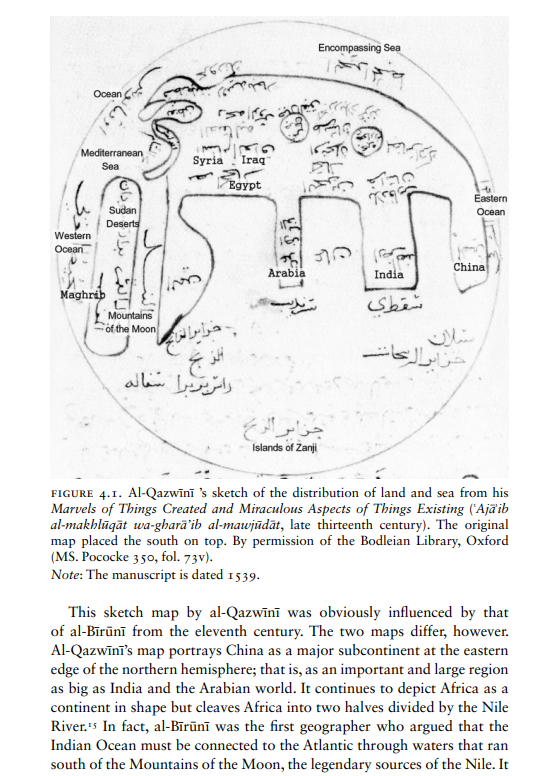
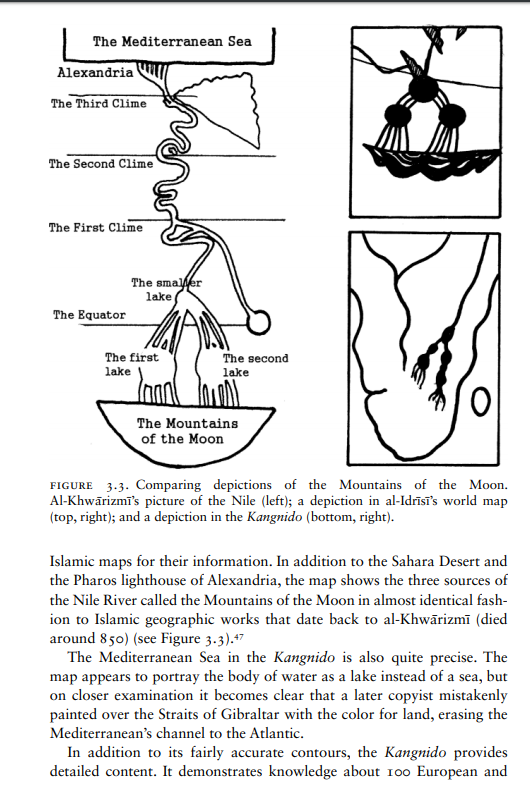
quote:
The traditional sources of the Nile River were thought to be in a mountain range called Mountains of the Moon by ancient Greek and Muslim
geographers. See Chapters 2 , 3 , and 4for its depictions in Muslim and
Chinese maps. The real sources of the White Nile were found only in the
mid- nineteenth century by the exploration of Sir Richard Francis Burton
and John Hanning Speke. On this topic, also see Christopher Ondaatje,
Journey to the Source of the Nile (Toronto, 1998).
quote:Can you do it? Is it on topic and in the same book?
Originally posted by Tukuler:
Hey
can ya give Ptolemy reconstructed MotM map the same treatment?
Please
quote:The Ptolemy world map is a map of the world known to the Roman Empire in the 2nd c. AD.
Originally posted by Tukuler:
Hey
can ya give Ptolemy reconstructed MotM map the same treatment?
Please
quote:It's not even on one of the archive sites that actually has the text of the thread because the images still go back to the Brian Dimambro
Originally posted by Tukuler:
I'm talking about Ptolemy map that used to be HERE.
Will search and restore if possible.
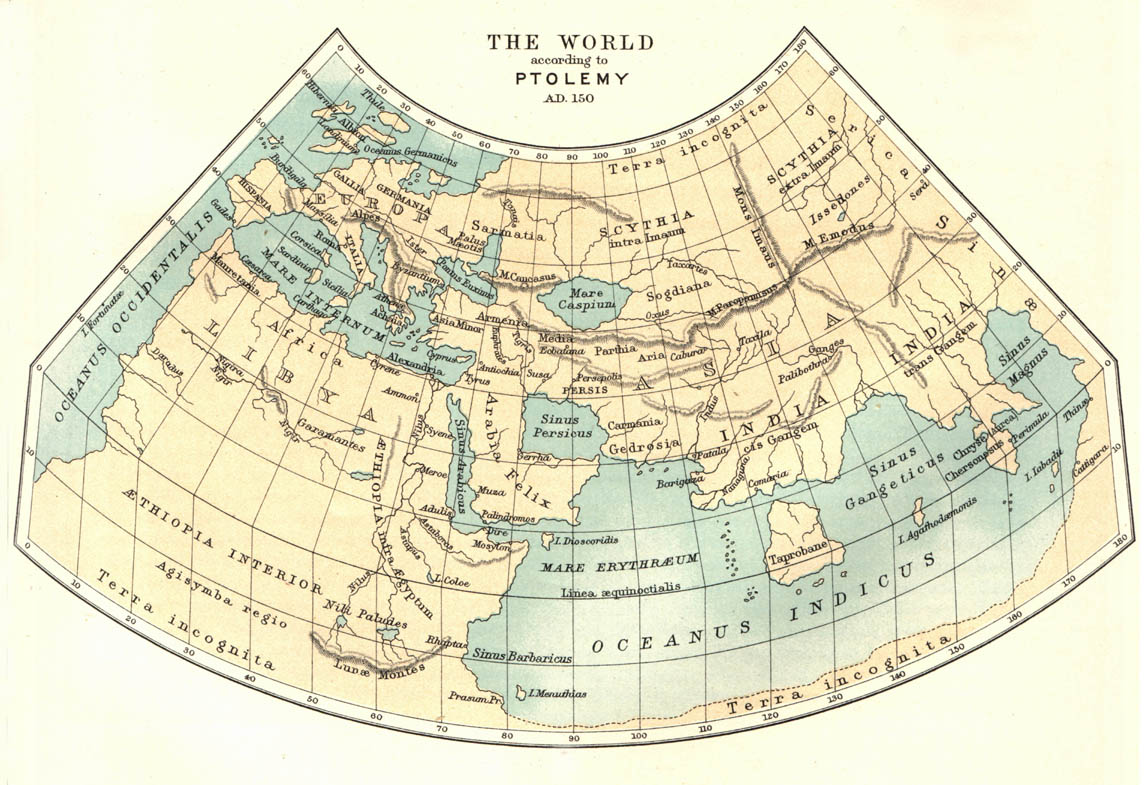
quote:just go back to that old post and right click on the little broken page error icon where the old photo was and keep an eye on the URL right after you paste it in the URL field
Originally posted by Tukuler:
Just to make sure
u r sayin
oldmapsbooks.com
is now antiquemapsprints.com
thx 4 yr help
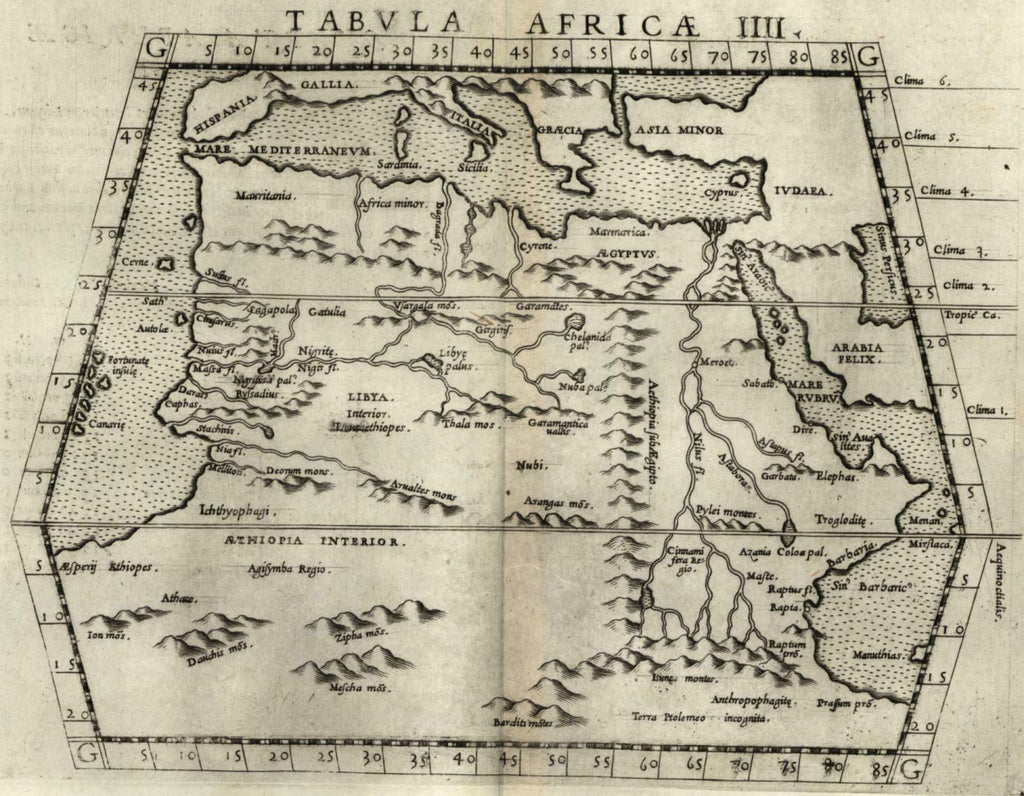
quote:I owe you big time Pussy Puss!!
Tabula Africae IIII.
(Ptolemy- Geography of the ancient world, Africa, Nile river, Mountains of the Moon, Libya).
Issued 1562, Venice by G. Ruscelli, publ. by V. Valgrisi.
Mid-16th century copper engraved map, depicting Ptolemaic geography. The mythical Mountains of the Moon are depicted as the source of the Nile.
